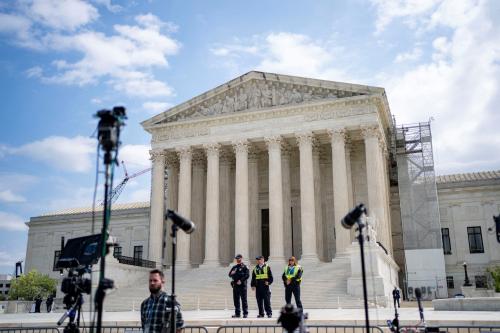Much has been written of late lamenting the difficulty of filling political appointments in the Obama administration, and rightfully so. As a recent Washington Post editorial pointed out, 20 career diplomats are awaiting confirmation for ambassadorships while an additional 13 ambassadorships are awaiting a nominee. The Senate’s decision to use the “nuclear option” has focused attention on the partisanship that traps qualified nominees in the confirmation vortex. But the statistic on empty ambassadorships illustrates that the problem is two-sided: the White House is often slow to nominate individuals to important posts.
In addition, there are simply too many positions that need to be filled through presidential appointments, and too many of those require the consent of the Senate.
The Senate recently took a stab at addressing this problem. In June, 2011, the Presidential Appointment Efficiency and Streamlining Act of 2011 passed the Senate with large bipartisan support. In 2012, having passed the House, the bill was signed into law. The law eliminated the need for Senate confirmation for 163 positions, and a Senate resolution, also adopted in June, 2011, established an expedited confirmation process for another 272 positions.
The law and resolution stemmed from a bipartisan deal announced by Reid and McConnell in January, 2011. The deal not only sought to address the nominations backlog, but also represented a commitment by both leaders not to support efforts to lower the votes needed to change the chamber’s rules. Given that the Democrats’ recent change to the filibuster rules governing most nominees was done through a simple majority vote rather than the two-thirds that had been standard for major rule changes, it’s unlikely that Republicans will come to the bargaining table again any time soon.
So what can be done? In a 2010 report, Brookings Senior Fellows William A. Galston and E.J. Dionne Jr. outlined a number of recommendations to improve the nomination and confirmation process for executive branch appointees, almost all of which are still relevant. There are steps the president can take on his own: supplement the FBI’s capacity by using the Office of Personnel Management for nominees’ background checks; make more effective use of private-sector headhunters to propose candidates for top positions; and establish a tiered system of background checks, from the most stringent for top-level positions through the least detailed for part-time commissions. These steps would help to more quickly get nominees to the Senate for consideration.
The Senate can also ease the process without new legislation: simplify the SF-86 form (clearance information) and the SF-278 form (financial disclosure information); and adopt a standard form for all Senate committees of jurisdiction over nominees.
These recommendations and other practical reforms were included in the report of the Working Group on Streamlining Paperwork for Executive Nominations, which was mandated by the 2011 legislation. Ultimately, the number of presidential appointments will have to be curbed if the system is expected to continue to operate at even its current, marginally acceptable level. Until then, however, bureaucratic reforms can go some distance toward addressing the problem.



Commentary
Easy Solutions for a Still-Broken Political Appointments Process
February 20, 2014